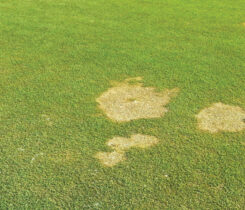See no weevil

Mike Kenna
Annual bluegrass weevils are a problematic insect pest to control in the Northeast. Making matters worse, several entomologists report an increase in adult pyrethroid resistance. Due to the resistance issues, golf course superintendents have turned to other insecticides.
The United States Golf Association (USGA) and Golf Course Superintendents Association of America helped support research that examined annual bluegrass weevil (ABW) insecticide resistance.
Albrecht Koppenhöfer, Ph.D., at Rutgers University showed pyrethroid-resistant adults were not as susceptible to other insecticide products. For example, chlorpyrifos was not effective at controlling resistant adult ABW populations. Also, indoxacarb and spinosad showed a similar decline in the control of pyrethroid-resistant adults. When treating larvae, only cyantraniliprole and spinosad were not affected by resistant populations. Indoxacarb, chlorantraniliprole, clothianidin and trichlorfon were less effective.
The researchers stress that insecticide resistance will be different for each golf course. Yet, the findings at Rutgers and other universities prove that insecticide resistance exists. They recommend minimizing insecticide applications for adult ABW control.
Monitoring and timing insecticide applications are vital.
Another approach is to shift control measures toward emerging larvae. Early larvicide applications can be timed by monitoring adults past their peak densities in the spring. Late larvicide applications require the monitoring of larval densities.
The ABW adult sampling article in this issue of Golfdom provides some useful information for you to use. Monitoring adult densities is more critical if you observe decreasing insecticide efficacy on your course.
If you think ABW adult resistance exists, Rutgers has developed a simple insecticide resistance test using formulated bifenthrin and chlorpyrifos. Consultants and diagnostic laboratories can use the test to determine the resistance level at your course.
The USGA is funding a new project evaluating other control measures in three states. Ben McGraw, Ph.D., Steve Alm, Ph.D., and Koppenhofer are conducting the research. Preliminary laboratory trials suggested that oils and petroleum-derived spray oils are capable of controlling adults.
Within three hours after application, Silwet and Civitas provided control of adults (greater than 80 percent). Neither product reduced larvae in the greenhouse or field. Also, Silwet applied at 9 ounces per 1,000 ft2 was phytotoxic and dropped from field studies.
Civitas applied at 8.5 or 17 fluid ounces per 1,000 ft2 performed the same for pyrethroid-resistant and susceptible populations. For several field trials in New Jersey, the Civitas rate was not a significant factor. Split or sequential applications in back-to-back weeks provided the most substantial reduction of adults.
Civitas alone, or in combination with a pyrethroid, may provide reasonable adult control. In 2018, Civitas suppressed resistant adult densities for all treatments (Civitas 50 percent, pyrethroid (Talstar) 44 percent, Civitas + Talstar 67 percent). Also, they reported larvae reductions for Civitas (48 percent) and the Civitas + pyrethroid (Talstar) combination (59 percent) but not Talstar (4 percent).
Controlling the ABW will continue to be a problem. I am excited about what we are learning about this insect pest, and we will continue to provide updates with the completion of more research. For now, try to monitor adult populations in the spring that will help extend the use of current insecticides. If you suspect adult ABW resistance, confirm your suspicions with the test developed by Rutgers.












